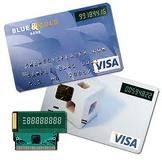Most credit card users in the U.S. are accustomed to swiping their cards through a machine that reads the information stored on the magnetic stripe, then signing their names on a paper receipt or electronic signature pad. Outside the U.S. - including many countries in Europe, Asia and South America - banks and retailers have switched to a system that reads information on a chip embedded in the card, then asks the user to enter a PIN. Canada is also switching to the "chip-and-pin" system.
Chip-and-pin cards, also called "smart cards," are generally acknowledged to be better at preventing credit card fraud. While cards with magnetic stripes are vulnerable to the possibility of being cloned through a technique called "skimming," it's not possible to clone a card that has a chip. It's also not possible to forge a PIN as one could forge a signature.
Still, traveling outside the U.S. with a "swipe-and-sign" card is often easy. American Express, MasterCard, and Visa require their merchants anywhere in the world to accept any valid card, including swipe-and-sign cards. However, there can be trouble if you try to use a swipe-and-sign card with an automatic dispensing machine, such as a train ticket vending system, roadway toll booth or parking lot pay station. If an attendant is present, he or she can accept a swipe-and-sign card, but if there's no attendant you may be out of luck.
A few U.S. banks are beginning to offer dual-mode cards that have both a magnetic stripe and an embedded chip, but so far these offers are limited. If a chip-and-pin card is not available to you before your next international trip, ask your travel professional for some advise about traveling with a swipe-and-sign card- such as knowing how to obtain cash at your destination.




No comments:
Post a Comment